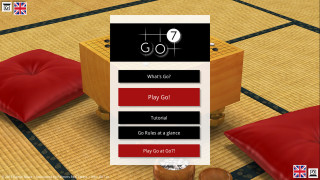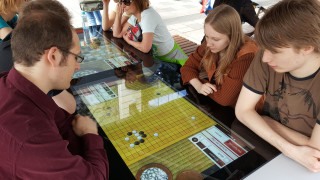Public Touchscreen Go Table
| Name: | Public Touchscreen Go Table |  |
| Contributor: | Daniel Bösze | |
| Organisation: | ||
| Edition: | 2015 | |
| Prize: | Winner |
Project Description
A public touchscreen Go table has been installed on Mariahilfer Straße, in the centre of Vienna, providing everyone regardless of age with an easy and inviting way to learn and play the game of Go. It features two 42" inch Full HD Screens in a weather-proof, unbreakable chassis that was customly designed. Running 24/7, protected from rain and sun by a pair of big sun shades, it is an extremely attractive spot for people to sit down and enjoy Go. Four players can play at once on the two screens with enough space for kibitzers.
People can:
- Play on three different board sizes: 9x9, 13x13, 19x19.
- Play against each other or against the computer.
- Learn Go interactively in an easy-to-follow step by step tutorial.
- Find out about the history of Go.
- Save and load their games for later review.
- Choose between different languages (German and English currently).
- Find out about the Go club Go7
- Watch a selection of famous professional games on the title screen.


Aim of the Project
With the touchscreen Go table on Mariahilfer Straße, we aim to give the game of Go as much public exposure as possible and let anyone in the public domain learn and play Go interactively, 24 hours a day with maximum attractivity.
Mariahilfer Straße is one of the busiest shopping streets in Middle Europe. Having been already crowded in 2011 with more than 70.000 customers daily, nowadays the popularty of it has soared to even higher levels thanks to the car ban. Mariahilfer Straße is especially popular with kids and students, but also with open-minded families and the young urban demographic.

Means of the Project
The Go table uses a complete custom design, because a similar public outdoor touchscreen table has never been created before. It is fully heated in the winter and cooled in the summer, with extra-bright screens and reinforced glass as a protection. During reconstruction of the street surface, a power line was laid to supply the table. The table along with its two concrete benches that were provided by the city are protected by two square 4 by 4 metres interconnected parasols. It is cleaned every two days by members of Go7. The software that runs on it has been specifically designed and written for the table and offers a simple and very intuitive interface.
Timeline
- June 2013 - Development start of a 3D Go Software, originally planned for tablets and phones.
- August 2013 - Start of a temporary pedestrian zone at Mariahilfer Straße shopping street, stirring huge controversy in car-affine Austria.
- October 26th 2013 - Birth of the idea for a public a go table in the new pedestrian zone during a brainstorming session after the Austrian Open 2013 Tournament.
- October 28th 2013 - Reaching out to different vendors of outdoor advertisement installations to get an idea about the costs.
- November 15th 2013 - Successful presentation of the rough draft project to the sponsor.
- November 26th 2013 - Presentation to the head of Neubau District, Thomas Blimlinger. The district promises support for the Go Table after a detailed presentation where a visualisation is shown, but asks for caution because of the then ongoing political debate about the permanent car ban on Mariahilfer Straße, which needs to be approved for the project to have any chance of implementation.
- March 7th 2014 - After months of heated public discussion and controversy, a public vote is held whether to keep the pedestrian zone and start the reconstruction of the street or to revoke the changes and reallow car traffic. The vote ends in favor of the pedestrian zone with an extremely narrow margin of 53% to 47%.
- March 18th 2014 - Final approval of the Go Table project by the district of Neubau.
- April 2014 - Start of detailed plannings and nerve-wrecking meetings with different city officials, planning bodies and architects.
- May 2014 - Start of the manufacturing of the touchscreen Go Table in China.
- June 2014 - Final approval of all construction plans for the site of the Go Table by all involved parties.
- August 2014 - Construction of the underground concrete foundation for the Go Table and establishment of the necessary power lines under the street.
- September 4th 2014 - Public announcement of the project in Austria's biggest online newspaper, Der Standard, with much debate and huge public interest.
- October 4th 2014 - Official opening ceremony with head of District, Mr. Blimlinger.
Geographic Extension
On one of the busiest shopping streets in Europe, Mariahilfer Straße, directly in front of Go7.
Results
Since the start of the project in October 2014, more than 15.000 games have already been played on the two screens. This amounts to nearly 100 games per day. Many new Go players have been attracted to Go7 because of it and a great number of children and adults try the game on the table every day. Of course some don't learn the rules and start to play right away, but even they have a great time. Often, there are people playing at the table who specifically come there to play Go.
Public Exposure
The project got huge exposure and quite a debate after the announcment of the project in Der Standard online newspaper, which enjoys the highest user counts of all online newspapers in Austria: Der Standard.
A public opening ceremony was held with Thomas Blimlinger on October 4th, 2014. Tables with Go boards, a Japanese food buffet and of course the Go Table itself attracted hundreds of people and was featured by Kurier, one of Austria's major newspapers: Kurier.
Since the Go Table is located at one of the most crowded spots in Vienna, it receives big attention. A large number of people are becoming new Go players every day.
Human Resources
The project was preconceived, created and implemented by Daniel Bösze, Board Member of the Austrian Go Federation. He spent nearly one and a half years voluntarily and unsalaried planning and designing the table itself, writing and designing the software and scheming and negotiating the Installation of the table on the street. Huge bureaucratic hurdles had to be overcome and everything had to be done in a very short time constraint since the project could only be implemented during the reconstruction phase of the street. Currently, he works on new features and improvements for the table's software.
Daniel had big support from the Austrian Go Federation, especially from Christian Anderson who served as a mentor and big advocate for the project, as well as from Michael Winkler, President, and Lothar Spiegel, who both made big efforts in supporting the project.
From the city of Vienna, Thomas Blimlinger, Susanne Hoeller, Robert Hart and Ulrike Pitro among many others helped to make the project a reality.
Financial Resources
The costs for the Go Table's hardware and its installation on the street were sponsored by the CEO of Palmers Immobilien AG. He also sponsored the parasols and financed the contract that had to be closed with the city. All in all, the costs of the project amounted to around $20.000, not including the work hours for the writing the software and planning the project which were unpaid. The table itself cost around $11.000.

Perspective
In the future, the Go Table will receive new features as the software is constantly developed further. Potential new features include:
- Support for other languages, such as French, Japanese, Korean, Hungarian, Chinese.
- Tsumego and other Go problems.
- Tutorials for advanced players.
- The possibility to play online, eg. on IGS.
Wishes
The goal for the project itself would be to install another touchscreen Go tables in Vienna or even in other cities around the world. Since the software is ready for any language, the hardware has already been designed and a lot of refinement and improvement has been done since the opening day, implementation of a similar project somewhere else will be a lot easier. We really hope that the success of our project inspires other Go communities to replicate the project.
Due to his day-to-day job as a 3D graphics artist, Daniel's ressources are somewhat limited in terms of how much time he can spend on improving the software. In order to speed up development and to enable a potential release of 3DGoban on other platforms like tablets, a sponsor would be needed.
Additonal Comments
Please find some additional images of the project along with some screenshots of the software here
